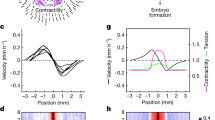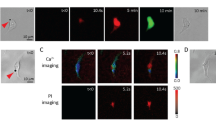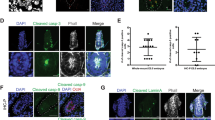Abstract
It has long been recognized that cells in early embryos can communicate with each other via a direct cell-to-cell pathway, probably mediated by gap junctions. Low electrical resistance pathways, detected electrophysiologically, have been identified in all species examined so far. However, studies in various embryos on the transfer of molecules larger than small ions (for example, fluorescent dyes in the molecular weight range 350–500) have given conflicting results1–5. In all these studies the ability to transfer dyes from cell to cell was determined without reference to the position of the injected cell in the embryo. In the experiments reported here, cell–cell transfer of the fluorescent dye, Lucifer yellow6 (molecular weight (Mr) 450) was re-examined in the early Xenopus laevis embryo by injecting the dye into identified cells, as the position of the injected cell within the embryo may be important. At the 32-cell stage, we found that dye transfer often occurred between animal pole blastomeres which were not sisters, as well as between sister cells, and also that Lucifer yellow was indeed transferred via gap junctions. The cell–cell transfer was not uniform within the animal pole; transfer was maximal near the dorsal side and minimal at the ventral side. This pattern may reflect differences in permeability or numbers of gap junctions across the embryo, and could be related to early events in development.
This is a preview of subscription content, access via your institution
Access options
Subscribe to this journal
Receive 51 print issues and online access
$199.00 per year
only $3.90 per issue
Buy this article
- Purchase on SpringerLink
- Instant access to full article PDF
Prices may be subject to local taxes which are calculated during checkout
Similar content being viewed by others
References
Bennett, M. V. L., Spira, M. E. & Spray, D. C. Devl Biol. 65, 114–125 (1978).
Lo, C. W. & Gilula, N. B Cell 18, 411–422 (1979).
Bennett, M. V. L. in Intracellular Staining Techniques in Neurobiology (eds Kater, S. D. & Nicholson, C.) 115–142 (Chapman & Hall, London, 1973).
Tupper, J. T. & Saunders, J. W. Devl Biol. 27, 546–554 (1972).
Slack, C. & Palmer, J. P. Expl Cell Res. 55, 416–419 (1969).
Stewart, W. W. Cell 14, 741–759 (1978).
Warner, A. E. & Lawrence, P. A. Cell 28, 243–252 (1982).
Weir, M. P. & Lo, C. Proc. natn. Acad. Sci. U.S.A. 79, 3232–3235 (1982).
Simpson, I., Rose, B. & Loewenstein, W. R. Science 195, 294–296 (1977).
Warner, A. E., Guthrie, S. C. & Gilula, N. B. Nature 310, 127–131 (1984).
Author information
Authors and Affiliations
Rights and permissions
About this article
Cite this article
Guthrie, S. Patterns of junctional communication in the early amphibian embryo. Nature 311, 149–151 (1984). https://doi.org/10.1038/311149a0
Received:
Accepted:
Issue date:
DOI: https://doi.org/10.1038/311149a0
This article is cited by
-
The role of gap junction membrane channels in development
Journal of Bioenergetics and Biomembranes (1996)
-
The connexin family of intercellular channel forming proteins
Kidney International (1995)
-
Histochemical detection of biogenic monoamines in developing amphibian embryos in health and during exposure to a static magnetic field
Bulletin of Experimental Biology and Medicine (1993)
-
Cell surface proteins of wholeXenopus embryos identified by radioiodination
Roux’s Archives of Developmental Biology (1989)
-
The origin of skeleton forming cells in the sea urchin embryo
Roux's Archives of Developmental Biology (1988)



